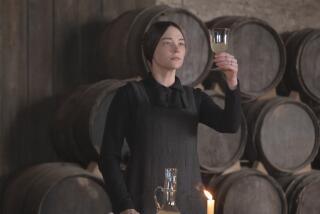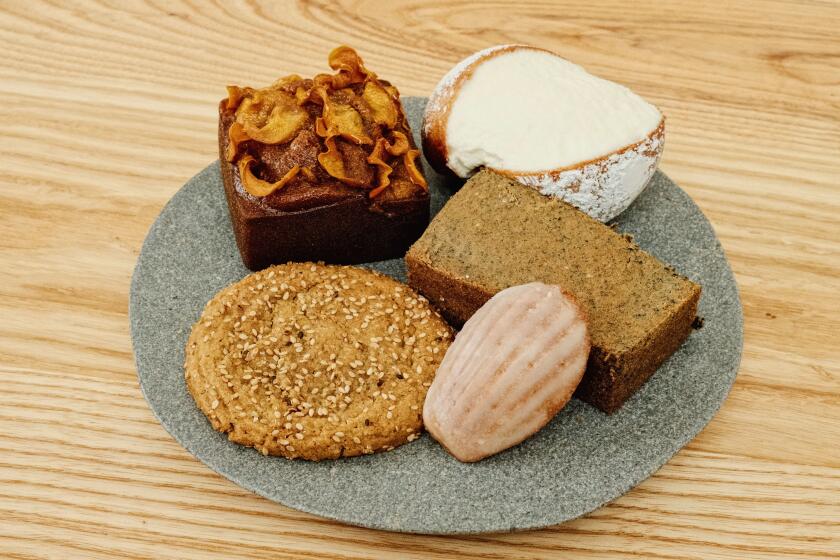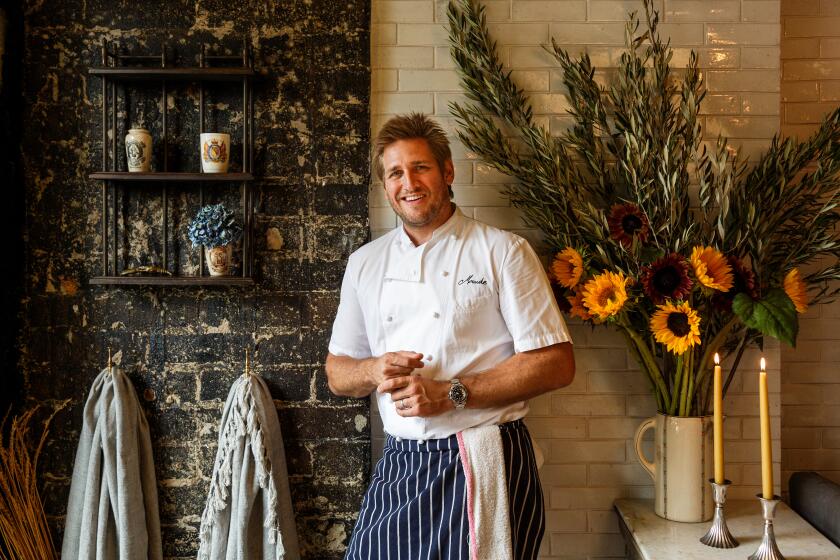Bringing out the gravitas in Grenache
It is hard to take Grenache seriously. Oh, sure, it’s serious enough in august bottles of Châteauneuf-du-Pape and Priorat, where the grape fills out the lion’s share of blends with an earthy depth and frequent profundity. But almost everywhere else the variety is grown, in Spain, Australia, southern France from Roussillon to the Rhône, it is a considerably more humble wine.
That seems to be its fate in California soils too, even though few red varieties are better suited to the state’s congenial climate: It’s one of those rare reds that stays in the game no matter what Mother Nature throws at it, as long as it’s sunny and warm.
Grenache in California has four great virtues: its deep garnet color, its abundant bright red berry fruitiness, its bracing acidity and a tannic payload that tends to strike as soon as it hits the mouth. But these can feel like a few spindly chairs in a sparsely furnished room: functional, but hard to integrate. An American Grenache can feel a bit primary, as if missing a dimension. It simply doesn’t fill the room.
“Grenache grows beautifully and easily, makes wonderful components for wines,” says Jason Haas of Tablas Creek Vineyards in Paso Robles, which employs Grenache in two of its blends. “But it’s hard to make a great wine with it on its own, or almost on its own.”
That doesn’t stop some wineries from trying, however, and the grape shows promise in a number of Central Coast locales, where, one way or another, winemakers are finding ways to bring out the gravitas in Grenache.
Grenache was among the first true French varieties to find its way into California soil, imported by enterprising Frenchmen who settled in and around the Mission San Jose after the Gold Rush. It was first documented in 1857 in the plantings of Charles Lefranc, whose family founded the New Almaden Winery, a vestige of which, Almaden, exists to this day.
Like most high-yielding varieties, Grenache was highly prized by the new settlers, and large tracts of Grenache vines were planted in Santa Clara County and remained until well after Prohibition, where it was used by wineries such as Almaden and Paul Masson to make cheap, dry rosés and “hearty Burgundy” type blends, as well as brandies.
Despite inexorable urban encroachment, several older vineyards survived into the early ‘80s, when they were discovered by Bonny Doon’s Randall Grahm, who employed fruit from 50-year-old vines in his early Rhône-inspired Le Cigare Volant blends, wines that had a strong hand in igniting the Rhône movement in California. I recently tasted the very first vintage of that wine, the 1984, and it was still an acclamation of Grenache’s best features: brilliant red raspberry and kirsch scents grounded with a rich, forest-floor earthiness, the textures still elegant and very much alive.
Vine age, in fact, does much to fill the room, but most of the vineyards that Grahm used have been torn up, and most recent plantings are still less than 20 years old.
So, short of waiting half a century, California winemakers have addressed Grenache’s missing dimensions by blending it with other varieties. Tablas Creek is a partnership between the Haas family and the Perrin family of Château de Beaucastel in Châteauneuf-du-Pape; clonal selections from Beaucastel account for much of the Grenache now in California soil. Tablas uses the variety as a component in its two red blends, Côte de Tablas and Esprit de Beaucastel. To Jason Haas, that is still its most important function.
“The whole idea in the southern Rhône is getting a more complete wine by blending,” says Haas. “That impression comes from more than one variety — Grenache works the front palate, Syrah works the back of the palate, and Mourvedre has tannins that hit the mid-palate. Together, they complete the experience of the wine in your mouth.”
Not only this, but Grenache’s other attributes, such as its bright fruitiness, complement Mourvedre’s more dour personality, and its acidity provides lift to your typical low-acid Syrah.
Between the two blends, the ’08 Côte de Tablas has a higher percentage of Grenache, not quite half (by contrast, Esprit leads with Mourvedre), and not surprisingly, it is the more forward of the two, with a bright red raspberry core — the Grenache, singing — with a brooding, meaty element with a hint of white pepper, the contribution of Syrah and other varieties. It is not the flagship wine of the winery — that’s Esprit’s role — but is a less expensive, more friendly, fruit-forward wine meant for more immediate pleasures.
Pleasure is the operative word for Steve Beckmen’s Grenache bottlings, which number three — a 100% varietal Estate bottling, a Purisima Mountain bottling that contains a healthy portion of Syrah and his annual Cuvee le Bec, a traditional Syrah, Grenache and Mourvedre blend meant for easy drinking.
“It’s more about pleasure and versatility,” he says. “There’s always a hedonistic appeal to young Grenache. Perhaps it’s a little simpler and more forward, but in all honesty, what’s wrong with that?”
Beckmen acknowledges that structurally Grenache can feel “front-loaded” in its texture, a sensation that he mitigates by co-fermenting Grenache with Syrah in his Purisima bottling. “We get a little more depth that way,” says Beckmen, “more structure, more length and back end.”
The other way to build up the texture of Grenache is to plant it in places where it really has to struggle. More than any other Rhône red, a Grenache vine is inherently vigorous, generating leaves and shoots willy-nilly and setting a huge crop if unchecked.
At his Purisima Vineyard, in Santa Barbara County’s Ballard Canyon, Beckman has planted his Grenache in some especially poor, rocky, limestone-tinged soils, which limits the vine’s growth and tends to make for smaller berries and clusters, usually resulting in more intensity and concentration. Spring winds, he says, curtail growth even further by limiting the initial set of fruit on the vine.
Next to Purisima in Ballard Canyon lies Stolpman Vineyard, where Grenache was grafted onto old Merlot vines first planted in 1995; it’s not exactly old-vine, but not young either. Sashi Moorman makes the wines there, and his Grenache style has evolved by embracing yet another common attribute in the variety: excess.
Moorman has come to believe that Grenache is at its best in California when it’s pushed to the limits of ripeness and alcoholic strength. “Even when it’s great, it tends to be quite alcoholic,” says Moorman. “It’s always a heady wine.”
As he addressed some of Grenache’s limitations, he found himself seduced by an extra dimension in certain bottlings, from wineries such as Saxum, Alban and Sine Qua Non. “They had this thing that I love in Châteauneuf that you don’t often get in domestic or Spanish wine; there was just this beautiful sensation, almost like liqueur on the finish, an aftertaste like pure liqueur,” says Moorman.
Only powerfully ripe fruit achieves this sensation, an amplitude that Moorman tethers by fermenting with a percentage of whole clusters — grapes and stems together. The addition of stems actually gives these heady, powerful wines some ballast, a freshness and suppleness of texture. “They bring the wine back to the center,” he says.
Craig Jaffurs, who has been making Grenache from Stolpman fruit for the better part of a decade, also throws a percentage of whole clusters in the fermenter. “We don’t use any new oak on our Grenache,” says Jaffurs. “We feel like the whole clusters add a little flavor but a lot of it’s textural — a little gravel in the texture. It makes for a more interesting wine.”
More to Read
Eat your way across L.A.
Get our weekly Tasting Notes newsletter for reviews, news and more.
You may occasionally receive promotional content from the Los Angeles Times.










